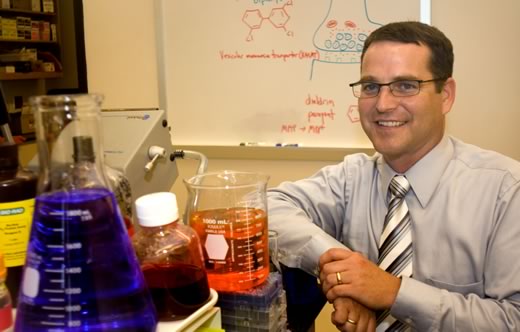Factoring the environment into Parkinson's disease

by Kay Torrance
Gary Miller's grant from NIH builds on previous studies using mouse models to link pesticide exposure to Parkinson's disease
|
|
RSPH's Gary Miller is leading a new multidisciplinary center to expand the study of environmental factors related to Parkinson's disease.
The Emory Parkinson's Disease Collaborative Environmental Research Center (Emory PD-CERC), funded by a five-year, $6.4 million grant from NIH, involves researchers from Emory and Georgia Tech to learn more about how pesticides and other agents may influence the disease.
"Exposure to various pesticides and PCBS [polychlorinated biphenyls] are thought to be involved in Parkinson's," says Miller, associate professor of environmental and occupational health. "It's likely that a combination of environmental exposures and genetic susceptibility ultimately leads to the disease. Although most people are diagnosed in mid- to late life with Parkinson's, experimental evidence suggests that neurodegeneration begins decades before a clinical diagnosis of the disease. Thus there should be opportunities to prevent or slow its progression."
Emory's PD-CERC encompasses three major research areas: determining the environmental contaminants that can interrupt storage of the neurotransmitter dopamine, determining how mitochondria respond to injury, and developing metabolic biomarkers to detect exposures and the disease itself.
Miller's research team recently established a mouse model of Parkinson's. They also identified a connection between exposure to the banned pesticide dieldrin during gestation and lactation and an increased risk of developing Parkinson's-like damage in laboratory mice.
"While many pesticides have been banned, they still remain in the soil and can take decades to break down, as in the case with dieldrin," Miller says. "We found that the pesticide does not directly kill the mice's dopamine neurons but makes them more vulnerable to Parkinson's."
Through the PD-CERC, researchers will study how various chemicals affect dopamine neuron function in order to identify which chemicals influence Parkinson's. They also plan to develop biomarkers to identify people exposed to suspected pollutants and determine if their exposure contributes to disease onset or progression.
To foster new research, the funding from NIH allows the PD-CERC to award three pilot grants for promising proposals each year. "In the past, these types of pilot grants have had a major impact by bringing new people and ideas to the field," says Miller. "We look forward to fostering new collaborations."



